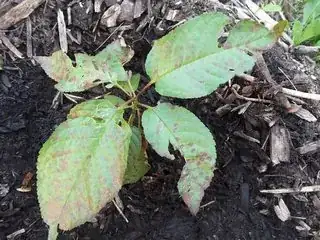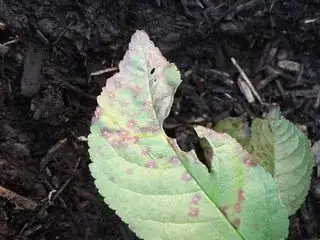Based on the information you have given, the most likely cause of the leaf problems is transplant shock compounded by overwatering. A photo and some information about where the seedling came from would be helpful for refining this assessment.
When a plant is transplanted, it loses a portion of its root system. Similarly, overwatering also damages the roots. In either case, the plant is trying to support itself on a much reduced root system. This accounts for the wilting. Note that this wilting does not indicate that the plant is dry, but, instead that the root's ability to take up moisture is inadequate. Providing a little temporary shade might help the roots catch up.
The stress induced by transplanting often causes plants to give up some of its leaves, usually the older ones. Leaves will yellow or exhibit typical autumn coloring, and then fall off. Often such leaves are affected by an opportunistic leaf spot disease. Identifying which fungus or bacteria is causing spots on an already dying leaf is probably not useful. Helping the plant overcome the shock of transplanting will be however.
So my suggestions are:
Water accurately. Do not use the plant's general demeanor as a guide for watering. Use your finger instead. Poke it into the soil to the depth of the plant's root zone. If it is dry, water. Otherwise, don't. Check often, watering only when needed.
Fertilize lightly. Use a soluble fertilizer at half strength in one of your waterings.
Provide some protection from heat, sun, and wind. Cherries like full sun, but, until it has adjusted, you may need to provide some temporary light shade. An occasional light misting during the heat of the day may be helpful. If it is exposed to a lot of wind, you may need to build something nearby to protect it as well.
Edit based on the newly provided photo:
On the positive side, the seedling has not yet given up on any of its leaves. The yellowing is from leaf spot disease. If it is a bacterial leaf spot, there is no treatment. If fungal, there may be. (I'm guessing bacterial.) In either case, keep the foliage dry, so ignore my previous misting suggestion, and try to increase air circulation. Otherwise, follow my water and fertilization suggestions.
The holes are caused by small caterpillars or maggots which are undoubtedly on the plant now. Look for them. When you find them, feed them to your local spider.
Overall, relax — autumn is coming soon. If the seedling has been growing happily in a pot for several weeks and only now after transplanting the leaf spots are starting win, it will likely be fine next spring.

 Click on the images for larger size
Click on the images for larger size